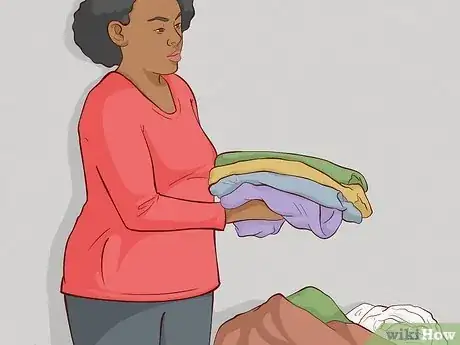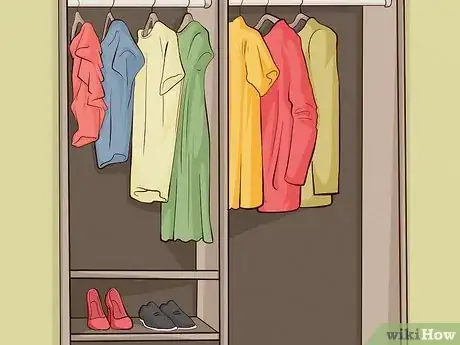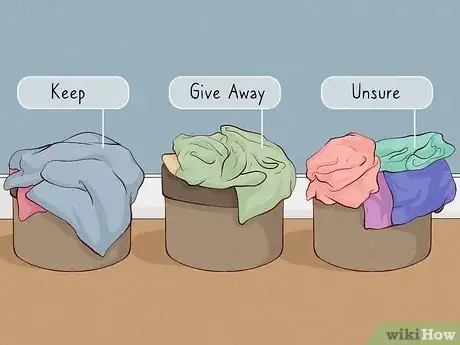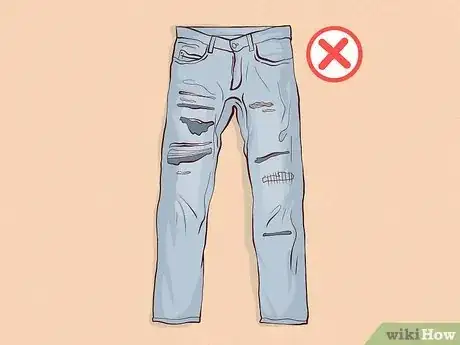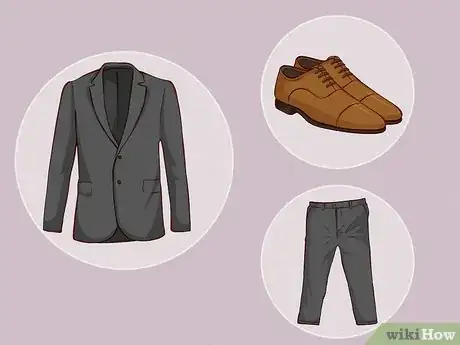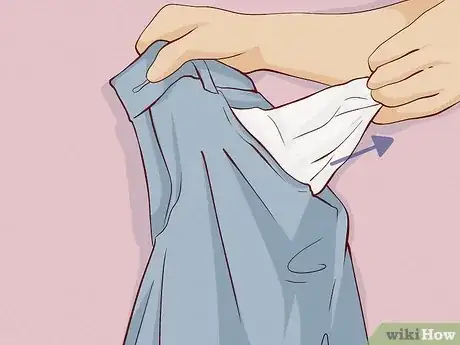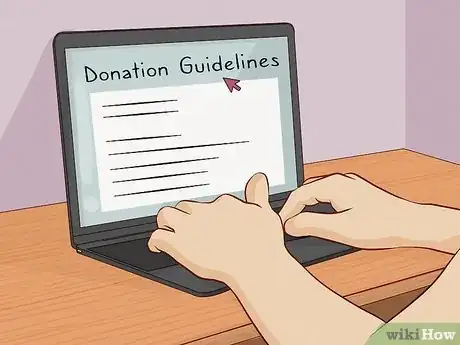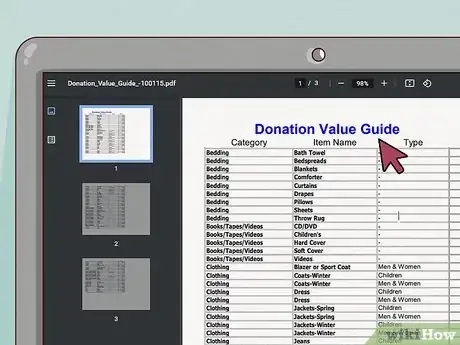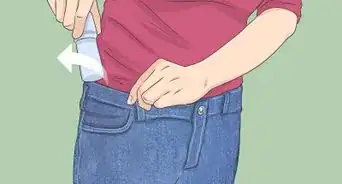This article was co-authored by Direct Relief. Direct Relief is an award-winning humanitarian aid organization, active in all 50 states and more than 80 countries. They focus on helping people affected by emergencies and natural disasters. Direct Relief has been highly rated by Charity Navigator, GuideStar, and the Center for High Impact Philanthropy at University of Pennsylvania, for their effectiveness, efficiency, and transparency.
There are 7 references cited in this article, which can be found at the bottom of the page.
This article has been viewed 193,995 times.
Everyone has things in their closets that they haven’t worn in years. But something you don’t love anymore could be another person’s new favorite outfit! To avoid throwing clothes away or having them clutter up your house, donate them to charities. Pick the right spot to drop off your clothes, decide what to donate, and ready your clothing for donation to make sure your items are put to good use for years to come.
Steps
Finding a Donation Center
-
1Do an online search to check your area’s options. Unless you plan to mail off your clothes to an online-only donation organization, it’s best to stick with local donation centers. This will make it easier to transport the clothing.
- To find a local spot, type “clothing donation centers near me” or “clothing donation centers in Seattle” into your favorite search engine.
EXPERT TIPDirect Relief is an award-winning humanitarian aid organization, active in all 50 states and more than 80 countries. They focus on helping people affected by emergencies and natural disasters. Direct Relief has been highly rated by Charity Navigator, GuideStar, and the Center for High Impact Philanthropy at University of Pennsylvania, for their effectiveness, efficiency, and transparency.Humanitarian Aid Organization
 Direct Relief
Direct Relief
Humanitarian Aid OrganizationMake sure the organization accepts donations of used clothes. Direct Relief, a humanitarian aid organization, says it's important to donate to a charity that specifically asks for secondhand clothes. "There are groups that specialize in accepting used items, or that hold drives for certain products. People want to help and they know that something could be useful to someone else, but the actual logistics of getting that clothing to a person in need can be difficult. The system needs to already be in place, or it can end up making a mess of an already delicate situation."
-
2Donate to Goodwill to support its employment mission. Most cities and even smaller towns have Goodwills. Goodwill is an excellent option for donation. They’ll accept all your items, and they put most of their profits back into job-training and employment programs for struggling workers in the United States.[1]Advertisement
-
3Give to the Salvation Army if you need a truck pickup. You can also find Salvation Army in most cities and towns in the United States. They may be best for families with really large donations, as they can pick up your clothes from your home.[2]
-
4Call homeless shelters to see if they need clothes. If you have homeless shelters in your area, give them a call. This may be a great way to get your clothing to people who need it most, right away. Call before dropping clothes off, however, as there may be better times for the shelter to handle drop-offs.[3]
- You should also call shelters for women and children who are victims of abuse, especially if you have professional women or children’s clothing.
-
5Drop off clothes with your local religious institution. If you belong to a religious organization, they’re likely involved in a running donation program. Check to see if they accept clothing, and when you can drop it off.
-
6Go online to donate unique types of clothing. If you have prom and wedding dresses, tuxedos, and older professional clothing lying around your closet, look for specialized organizations online. There are lots of foundations that are dedicated to collecting and selling just one type of clothing.[4]
- For prom dresses, try Fairy Godmothers Inc.
- For wedding gowns, visit the website of Brides Across America.
- For professional clothing, use Dress for Success (for women) or Career Gear.
Picking Stuff to Donate
-
1Set aside a whole day to clean out your home. Choose a day when you don’t have anything else going on, such as a free Saturday or a day off work or school. Sorting through clothes can be time-consuming, and you don’t want to get frustrated because you run out of time in the middle of your de-cluttering extravaganza.
- To make this process more fun, put on some upbeat music while you sort.
-
2Focus on closets. Closets, more than other spots in your house, collect things. These will be the areas of your home where most unused clothes and shoes are located. Start with bedroom closets, and then move to any hall or storage closets.[5]
-
3Sort your clothes into piles for keeping and giving away. If you haven’t worn something in over a year, consider giving it away. If something doesn’t fit you, it may also belong in the donate pile. Remember, something that’s no longer perfect for you could be someone else’s treasure.[6]
- You can make three piles: “Keep,” “Give Away,” and “Unsure.” At the very end of your sorting, revisit the “Unsure” pile and ask yourself “will I really wear this again?” for every item.
-
4Choose items that are in good condition. While it may be tempting to give away that pair of totally ruined jeans, resist that urge. You’re creating more work for donation centers when you give them items that can’t be reused by other people.[7]
- For clothes that are in total disrepair, consider ripping them up to make cleaning rags. You can also look online for clothing recycling centers, which are different than donation centers.
-
5Give away professional clothing to help job-seekers. People who are out of work often rely on donated clothing for interviews. They may not be able to afford full-price suits, shirts, and slacks, so anything you donate could be put to very good use.[8]
- Professional shoes are also in high demand.
- Even out-of-date professional clothing can be useful. People may be able to have these items tailored and still spend less than they would on new professional clothing.
-
6Donate shoes. Shoes that are in good condition can be donated. Do not donate shoes that are out of shape or have worn soles though, as people won't find these useful. Shoes that have good soles, have kept their shape, are clean and have all fittings like laces still intact make perfect choices for donating. Sandals, boots and sneakers are also wanted items in charity stores.
Preparing Your Items
-
1Check the pockets for loose items. Make sure you’re not giving away loose change, jewelry, or keys along with your clothing! It could be very difficult for donation centers to get these items back to you.
-
2Launder any clothes you plan to donate. Be sure you’re not donating dirty or smelly clothes. Use an unscented detergent to avoid triggering anyone’s sensitivities. Fold the clothes before you get them ready for transport.
- If you’re donating items that need to be dry-cleaned, do this before you donate as well.
- Baby clothes and accessories need an especially good cleaning, but be sure to use detergents that are safe for babies’ skin.
-
3Check on your donation center’s rules. Some donation centers will ask you to put all your clothes on hangers. Others might want them neatly folded, and don’t want you to give them any hangers. Go online or call to make sure you’re sticking with the guidelines for the donation center you’ve picked.
-
4Do not leave pins or staples in clothing. Leaving sharp pins or staples in clothes could injure the people sorting them at the donation center. Unless safety pins are part of the item (like a pair of distressed jeans), remove these as well.
- If you’ve never worn the item, you can (and probably should) leave the tag on.
-
5Pick a large box or bag to transport the clothing. Use a large cardboard box, plastic bin, or heavy-duty trash bag. Once you’ve filled it halfway, test to make sure you can still lift it. Keep filling it up until it’s full or just at your lifting limit.
- If you want your plastic bins back, you may want to stick with cardboard boxes and bags. Especially if the center is busy, they may not have time to immediately empty bins and give them back to you.
-
6Know the requirements for getting tax deductions. In the United States, you can receive a tax deduction for charitable donations, which could slightly reduce your taxable income. Itemize your clothing donation and estimate the “fair market value” of each piece. This means you’ll need to determine about how much you could have sold the clothing for.[9]
- In order to qualify for deduction, your charitable organization needs to be legitimate. Read the IRS’s publication on rules for donation to check the requirements for donation centers: https://www.irs.gov/pub/irs-pdf/p526.pdf.
- Ask the donation center for a receipt each time you donate to keep in your records in case of an audit.
- Most countries around the world have options for deduction in their tax codes. Contact your local government officials to find out the specific rules for your nation.[10]
- Goodwill provides a handy value guide that may help you itemize your clothing. You can find it here: http://www.amazinggoodwill.com/hubfs/docs/Donation_Value_Guide_-100115.pdf.
Warnings
- Don't place anything other than clothes in clothing bins. Breakables could break and injure collecting the items.⧼thumbs_response⧽
- Make sure you arrange a time to drop off the clothes or know that the place you are going to is open. Don't leave clothing at the doors. This encourages theft.⧼thumbs_response⧽
Things You'll Need
- Containers such as boxes, bags, etc.
- Clothing
- Scent-free laundry detergent
References
- ↑ http://www.huffingtonpost.com/2015/05/05/donate-clothes-beauty-products_n_7192358.html
- ↑ http://www.huffingtonpost.com/2015/05/05/donate-clothes-beauty-products_n_7192358.html
- ↑ http://www.slate.com/articles/life/my_goodness/2010/08/the_shirt_off_my_back.html
- ↑ http://www.huffingtonpost.com/2015/05/05/donate-clothes-beauty-products_n_7192358.html
- ↑ https://bemorewithless.com/goodcloset/
- ↑ http://theeverygirl.com/7-questions-to-ask-when-cleaning-out-your-closet/
- ↑ https://www.charityretail.org.uk/donating-to-charity-shops/
- ↑ http://www.huffingtonpost.com/2015/05/05/donate-clothes-beauty-products_n_7192358.html
- ↑ https://www.irs.gov/uac/eight-tips-for-deducting-charitable-contributions
About This Article
There are a number of ways to donate your old clothes to charity and give them new life. Search online for clothing donation centers or local homeless shelters in your area. Many cities and small towns also have a Goodwill store where you can take your clothes. If you’re part of a church, ask if it takes clothes donations. Another great option is Salvation Army, which will collect your clothes from your home if you have a lot to donate. Wherever you decide to donate your clothes or shoes, only donate items that are in good condition that people can actually wear as they are. You should also wash them first so people can wear them right away. For more advice from our Charity co-author, including how to donate clothes online, read on!






